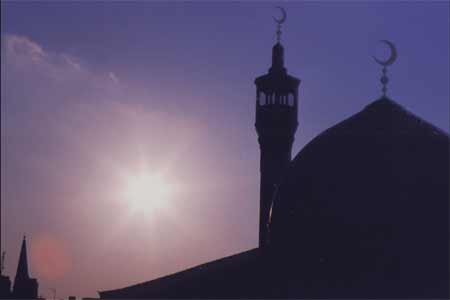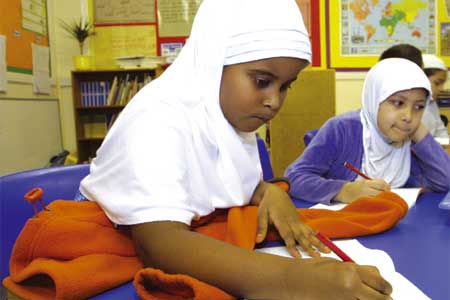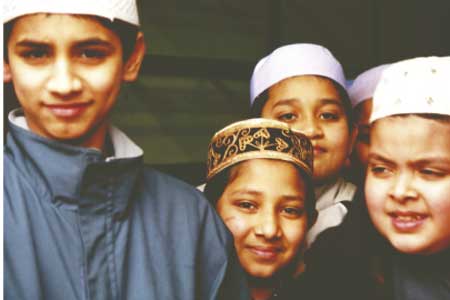
Forging Into a New Era: East London Mosque
Issue 1 Sept / Oct 2003
Muslim institutions and centres have come a long way from make-shift rooms and unassuming buildings that used to be the destination of those following the call to prayer. Now, local mosques are the epicentre of religious and social interaction, integrating with mainstream society as well as providing vital services to the community.
From an East London street corner the adhan, the call to prayer, can be heard. It bellows out from the golden minarets of the East London Mosque (ELM), calling Muslims in a one-mile radius to their daily prayers.
In fact, it is the only place in Britain where the adhan summons worshippers beyond mosque walls. Built in 1985 by a burgeoning Bangladeshi and Somali community, the ELM received local council permission to project the call from booming speakers. And in this corner of the city, where the size of the Muslim population rivals other ethnicities, the mosque is the hub of an Islamic community forging into a 21st Century Western society.
"We don't go to pubs and bars on a Friday night, we can come here," said Masuma Haque, a young woman who attends the mosque on a regular basis. "It is a safe Islamic environment."

Masuma and a group of young men and women were greeting visitors to an Open Day, when non-Muslims are welcomed into the mosque for tours, literature, exhibitions of Islamic study and lifestyle, film shows as well as food and drink. The open days are offered regularly in addition to multi-faith talks and the cultural awareness week held annually. Each week more than fifty people take advantage of their open door policy, bringing questions, curiosities and interests.
The ELM takes a proactive approach to promote Muslim life in modern society. "We are looking to present a positive image of Islam to the non-Muslim community and dispel many of the misconceptions people have," said Mizan Amin of the Community Cohesion Project, which works to strengthen community relations. Many visitors to the mosque are local school groups coming to learn about Islam, and there are adults who come too, with queries and questions.
A cultural awareness training programme is the next endeavour for Mr Amin and the community cohesion project. In the past the ELM has provided information to public workers who come in contact with Muslims such as teachers, social workers and police officers. They are currently devising a specific programme for professionals.
Beyond their efforts to welcome non- Muslims and community members, volunteers reach out to those in need of counselling. They also offer Bangla and Somali language classes to children, Arabic classes and a drug information project, in addition to ongoing social events. Many adults take advantage of English language lessons, seminars, workshops and casual talks discussing everything from daily prayer to international current affairs in sessions geared toward all age groups.

"The mosque provides a platform for the community to gather, confront their faults and find solutions," said Nozmul Hussain, a co-ordinator for a local awareness project, which sponsors open days and other ctivities. "It is a place where people can come without feeling fearful. The services provided can be accessed without any sense of intimidation."
This safe space is particularly important to the sisters of Women's Relief. Women can be certain to receive confidential and sound advice regarding marriage, divorce, cultural and health issues. Coffee mornings and women-only sessions where ladies can make use of the exercise facilities, as well as receive a bit of pampering, provide an opportunity to socialise and relax.
Women are gradually moving beyond traditional stereotypes and are encouraged to take a proactive role. "Women are the primary educators of the children. So women must be educated, articulate and confident if we expect our children to be intelligent," said Mr Hussain.
The ELM goes some way towards countering the teachings of a state system that it feels often misinterprets Muslim history. Whether it's the 'barbarians' of the Crusades or the 'tyrants'of the east, an Islamic perspective is typically not offered in mainstream schooling. According to Mr Hussain, the state schools do not offer an environment conducive to the Muslim child.
The ELM hosts a number of different educational opportunities for young and old and Hussain hopes to counter what he perceives to be an identity crisis among Muslims. The classes for adults are popular while over a hundred children attend evening MADRASAH to learn the Qur'an and Islamic teachings.
The ELM has launched its own primary school. The Adam School began in September with a pilot class consisting of 30 boys and girls at the third-year level who are instructed by a former state school teacher. In four years time success will be assessed, teething problems remedied, and it is anticipated the Adam school will open its doors to 180 students and operate full time.
To accommodate such a large number of worshippers and service-users, expansions to the building structure are being drawn up. Already underway, a £9m addition will make the ELM the largest Islamic centre in western Europe.
A six-storey building combining the geometrical symmetry of Islamic architecture with local materials and modern conveniences will connect to the mosque. It will provide classrooms for educational facilities for children and adults, two multi-purpose halls, additional WUDHU (washing) facilities, nursery and crèche, a youth centre and gym. The aim is also to ensure better interaction with non-Muslims by building a library and resource centre and workspace for local businesses. The whole complex (including the current building) would be enough to accommodate up to 10,000 worshippers for the JUMM'AH (Friday) prayers.
"There is much optimism and enthusiasm here because everyone feels a part of the mosque. We are trying to make this the focus of the community," said Mahera Ruby, a teacher and educational consultant, and long-time resident of the area.
Half of the money needed has already been raised through community donations, grants and fulltime fundraisers are appealing to international liaisons for further backing. Workers began construction in November of 2002 with hopes of completion by early 2004.
With this massive expansion project and its progressive approach to Muslim integration in the UK, the East London Mosque is exemplary of UK Mosques in the 21st century. And as Nozmul Hussain said, "We are building a Centre of Excellence for the Muslim community in the West".
words: Sarah Dadlani
images: Rehan Jamil
Bookmark this |
|
Add to DIGG |
|
Add to del.icio.us |
|
Stumble this |
|
Share on Facebook |
|
Share this |
|
Send to a Friend |
|
Link to this |
|
Printer Friendly |
|
Print in plain text |
|


Comments
0 Comments